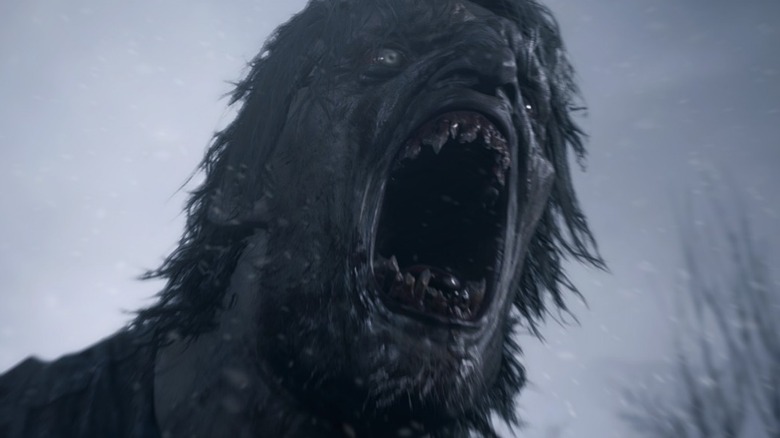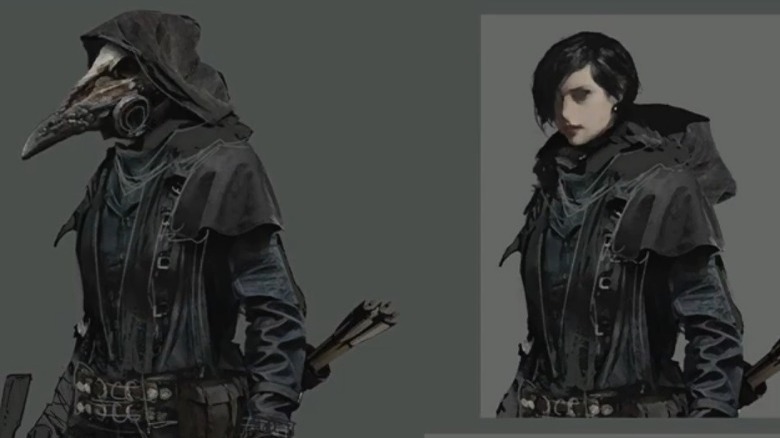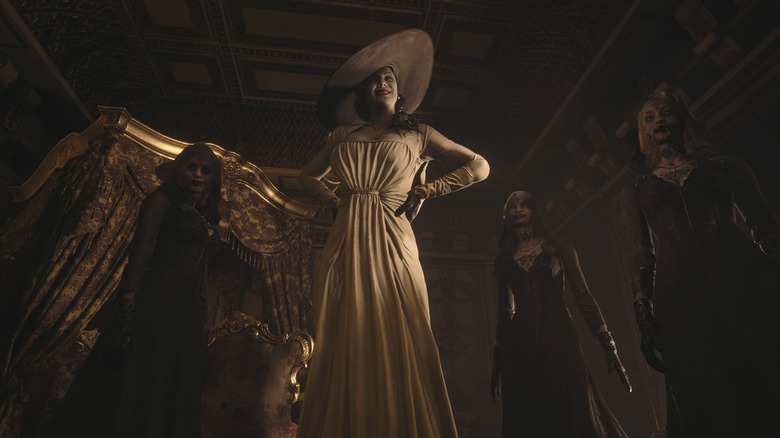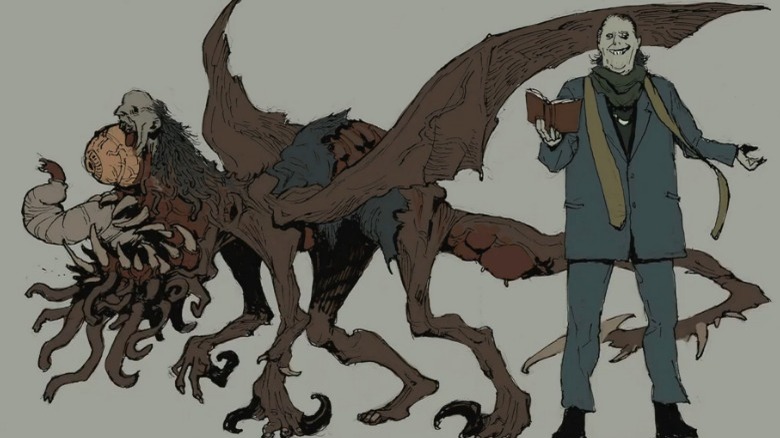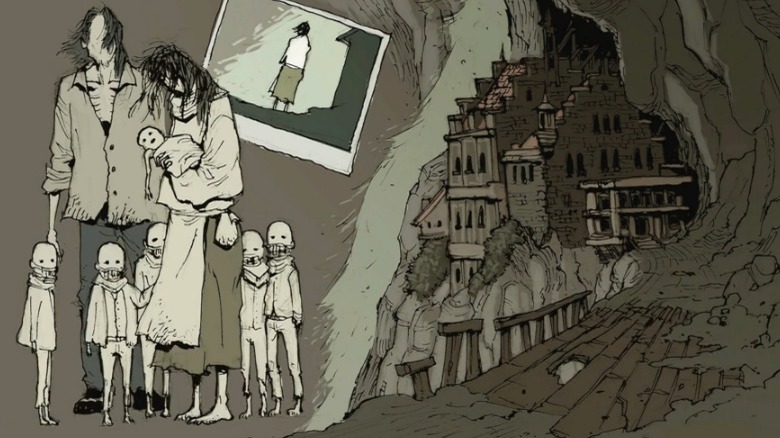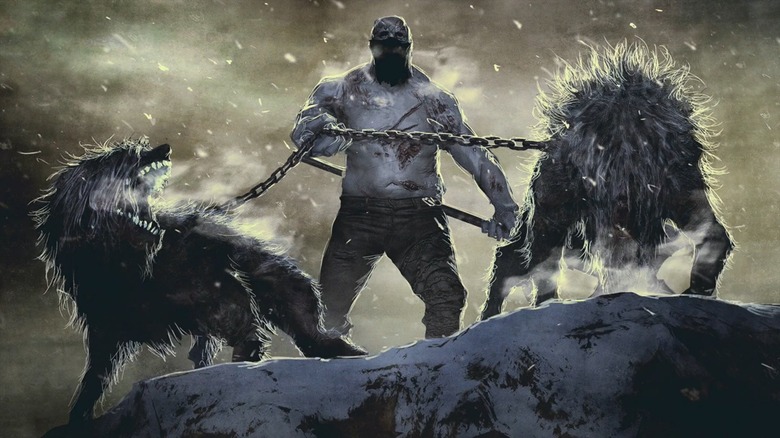Resident Evil Village Characters That Were Left On The Cutting Room Floor
While many creative types would probably love to work on a video game, it is not an easy process by any stretch of the imagination. You have to design a ton of NPCs, protagonists, and enemies — far more than necessary, because a good chunk will probably be thrown out. Perhaps a designer has an idea for a visually impressive monster, and the gameplay designers can't wrap their heads around implementing it. Or, maybe a sudden change in vision and story renders a previously solid concept moot. The "Resident Evil" franchise is the poster child of this unsung truth of game design, and that's as true as ever with the latest entry, "Resident Evil Village."
Throughout the history of "Resident Evil," numerous zombies and other Umbrella-funded crimes against nature have been designed and cut from the final product, and "Resident Evil Village" includes its fair share of axed abominations. Some of these ideas were refined (e.g., Alcina Dimitrescu was originally a hooded vampiress with giant garden clippers instead of Tyrant-like claws), while others were left abandoned, only seeing light in art books and DLC extras.
"Resident Evil Village" could have been a very different game, and not just because it almost wasn't a sequel to "Resident Evil 7." Here are a few of the NPCs and enemies players could have encountered if development had taken a different path.
Contains minor spoilers for "Resident Evil Village."
Ada Wong
The biggest plot twist in "Resident Evil 7" wasn't that the infirm "grandmother" players occasionally encountered was actually the fungus-spewing source of the game's mold zombies and superpowered Baker family. That honor belongs to the last-minute appearance of Chris Redfield. "Resident Evil Village" almost followed that tradition and included another fan favorite character: the franchise's matron of mystery, Ada Wong.
If you purchase the Trauma Pack DLC, you will receive, among other things, a digital art book that contains early and unused concepts for both "Resident Evil 7" and "Resident Evil Village." One of the forgotten ideas for "Village" was Ada Wong. Unlike her previous adventures, which saw Ada don a red femme fatale dress, this time she would have dressed a little more appropriately for zombie action. Ada would have still wielded her signature crossbow, but she would have actually lived up to her spy profession's creed and hidden her identity in a "Bloodborne"-esque plague doctor getup.
According to the art director's comments (which accompany every piece of art in the DLC), Ada was originally supposed to investigate the village and save Ethan Winters. But as development went on, she was completely removed due to "a number of conflicting scenarios." With any luck, Ada and her new design will be recycled for future DLC.
More Dimitrescu daughters
Most marketing materials and trailers for "Resident Evil Village" featured the gargantuan Alcina Dimitrescu and her swarming daughters. Given this attention, you might assume the Dimitrescu bloodsuckers would serve as the game's main antagonists. Spoiler alert: they don't. But perhaps this marketing obsession was a holdover from when the daughters were envisioned as somewhat frequent enemies.
A recent PlayStation Blog interview dived deep into the design elements of the Dimitrescus. While their wardrobe inspirations and backstory were a main focus, the interviewer eventually asked the game's director, Morimasa Sato, why the team settled on three daughters. According to Sato, earlier versions of "Village" birthed a whole vampire witch's coven of smaller Dimitrescus. In the end, the team slashed all but three Dimitrescu daughters for the sake of game balance.
While Capcom eventually settled on the idea of making each daughter a sentient swarm of insects, they went through a ton of other conceptualizations. For example, an early design consisted of the daughters mummifying if they didn't receive a constant stream of blood. Another had the daughters' heads unfold into wings like an unholy cross between a J'avo from "Resident Evil 6" and the head-munching alien spores from "Parasyte."
Ultimately, the dev team had to scrap many of their ideas because they didn't make the daughters "come across as 'bosses.'" Of course, the flying daughter concept was recycled for a different enemy, so it wasn't a total loss.
Osmund Saddler 2.0
Because "Resident Evil Village" takes place in, well, an old European village, it's easy to make "Resident Evil 4" comparisons. Turns out the similarities are much deeper than the setting.
One of the first ideas for a final boss was that of an evil religious leader, and that concept did make it through development. However, instead of the current Mother Miranda, the main antagonist was at one point an unnamed male priest figure. And for his fight, he would mutate into a giant cyclopean dragon-like creature with his previously-human mouth for an eyebrow. Why wasn't Mother Miranda the final boss early in development? Because back then she was Dr. Miranda, and she was in the village to research its lycans and other monstrosities, not lead them.
The design for the male priest, along with his dragon form, were ultimately dropped, possibly because it was too similar to the final boss and main antagonist of "RE4," Osmund Saddler. Their final forms even shared the common design element of a giant, orange eyeball bursting from a mouth. But, as with many ideas, the dragon-form concept was recycled, in this case for Alcina Dimitrescu and her boss fight. Moreover, Miranda took over the role as big bad cult leader.
It's all in the family
While Alcina Dimitrescu and her daughters were some of the first villains introduced for "Resident Evil Village," gamers eventually learned they were only a small piece of the puzzle. Throughout the game, players have to deal with three other monstrous mafiosos: Karl Heisenberg, Salvatore Moreau, and Donna Beneviento. These characters, along with Alcina, make up the four "families" in charge of the village. But only Alcina has kin, specifically daughters (even though the game and prologue imply they aren't blood relatives), so where did the term "family" come from? Possibly initial design ideas.
Early in development, the Beneviento and Heisenberg families were just that: families. While the Beneviento house remained a building in front of a waterfall throughout game iterations, the family itself was initially envisioned as a "ghost family," complete with masked parents and muzzled children. Meanwhile, the Heisenberg family was not that different from the final product. Karl was still there, but he had a twin brother. Moreover, the Heisenberg twins had a living mother — if you can call being strung up like a puppet with an exposed brain "living."
Even Salvatore had a family of sorts. His design didn't change much from conception, but instead of hosting a parasite buried beneath all his tumorous eyes, he carried around "a girl he once had feelings for" inside his back.
Lycan Vârcolac handler
Recently, "Resident Evil" has given the classic zombie tropes that birthed the franchise a vacation and explored other avenues. "Resident Evil 4" started that trend with the Las Plagas parasites, "Resident Evil 7" introduced its own take on the fungus zombies trope, and "Resident Evil Village" took a hard left into werewolf country. Since many different cultures have their own werewolf legends, Capcom had a lot of inspirations to draw from. One idea asked an intriguing question: What if a werewolf kept another werewolf as a pet?
In "Village," the "lycan" breed of werewolf is a common enemy and comes in normal and large varieties, but larger lycans aren't in charge of the pack. That distinction lies with even bigger boss creatures like the Vârcolac and Uriaş. Unlike normal lycans, Vârcolac are far more wolflike, their previously human features gruesomely distended into long snouts and digitigrade legs. Meanwhile, Uriaş is just an extra-large lycan with a giant hammer. One cut enemy combined these alpha leaders into a terrifying duo ... or trio, in this case. Early into game development, designers came up with the idea for a "large lycan who commands two chained Vârcolac." You read that correctly: not one Vârcolac, but two.
While the art director's comment doesn't state why the enemy was cut, it might have been for the sake of game balance. Maybe two Vârcolac and a giant Uriaş-like lycan, all bullet sponges in their own right, were just too much.

